Did you know that there are over 165,000 known species of caterpillars in the world? These fascinating creatures come in all shapes and sizes, each with its unique characteristics. Caterpillars are classified as insects and belong to the order Lepidoptera, which also includes moths. In the beautiful state of Idaho, you can find approximately 58 different species of caterpillars. Beneath our gaze lie the myriad ecosystems of Idaho, harboring a mesmerizing realm of caterpillars that infuse our world with a sense of enchantment and exploration. The caterpillars in Idaho live in various habitats throughout the state such as lush forests, picturesque meadows, and enchanting gardens.
How Are Caterpillars Classified?
Welcome to the enchanting realm of caterpillars, a world brimming with captivating facts and intriguing behavioral patterns. Caterpillars are categorized (and classified) based on their physical attributes, such as body shape, leg count, and the presence or absence of spines. This classification offers valuable insights into their biology and behavior.
Their bodies are generally divided into three segments: the head, thorax, and abdomen, each playing a crucial role. The head houses sensory organs, the thorax facilitates movement, and the abdomen contains the digestive and reproductive systems. Unique leg arrangements and defensive spines contribute to their complexity. Moreover, caterpillar behavior varies, with some leading solitary lives and others being active during the day or night.
A Caterpillar’s Metamorphosis

The monarch
butterfly
caterpillar takes about three to eight days to incubate.
©iStock.com/CathyKeifer
A caterpillar’s metamorphosis is a remarkable transformation that takes place in four stages: egg, larva, pupa, and adult. Caterpillar metamorphosis is a fascinating and intricate process orchestrated by hormones. One key hormone, called ecdysone, triggers the caterpillar to molt, initiating its pupa stage. In contrast, the juvenile hormone plays a vital role in delaying the caterpillar’s transition into adulthood.
Once the production of juvenile hormones ceases, the caterpillar gracefully enters the pupa stage, setting in motion the remarkable phenomenon of metamorphosis. This captivating process, essential for butterflies and moths to survive, allows them to undergo a remarkable transformation from one form to another. The duration of caterpillar metamorphosis varies across species. For example, the monarch butterfly achieves this process within a month, while the silkworm moth may take several months.
Caterpillars Found in Idaho
Idaho, located in the northwest region of the United States, is known for its remarkable variety of caterpillar species. With approximately 58 different types documented, these fascinating creatures contribute to the rich biodiversity of this beautiful state. While the exact count may vary across different sources, the unique and awe-inspiring nature of these caterpillars remains unchanged. In this exploration of Idaho’s diverse ecosystem, let’s delve into some of the more common and most notable caterpillar species found in Idaho’s captivating landscapes.
Moth Caterpillars in Idaho
1. Promethea Moth Caterpillar (Callosamia promethea)
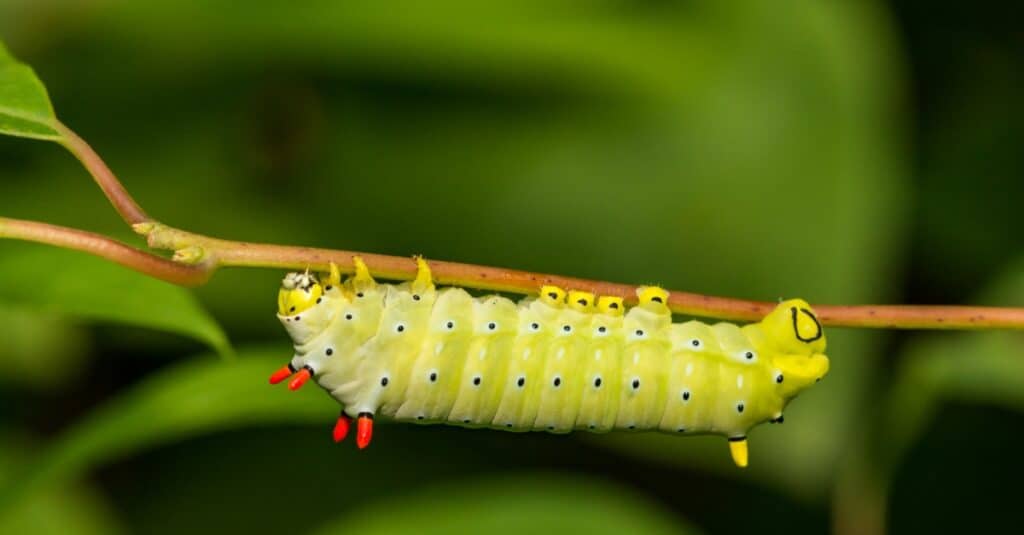
The adult moth of the Promethea caterpillar emerges from a silk cocoon in the spring.
©Jay Ondreicka/Shutterstock.com
If you live in the state of Idaho, you may be lucky enough to spot a Promethea caterpillar. This colorful species lives in many parts of the United States but is particularly common in Idaho. A member of the Saturniidae family, these caterpillars have a striking pattern of black, yellow, and white stripes. The Promethea caterpillars feed on a variety of deciduous trees including maples, oaks, hickory, and willows. They also enjoy munching on flowers such as thistle and dock. As they grow older, they can measure up to 2 inches in length. When full-grown, they form a chrysalis and eventually emerge as an adult Promethea moth.
2. Cecropia Moth Caterpillar (Hyalophora cecropia)

Cecropia caterpillars have stunning colors and unique patterns.
©K Hanley CHDPhoto/Shutterstock.com
The cecropia moth caterpillar, a striking example of North America’s largest silk moth, is abundant in Idaho. With a length of up to 5 inches, this caterpillar exhibits vibrant green hues with white stripes and eyespots on its back, serving as a deterrent to potential predators. It sustains itself by feeding on wild cherry, willow, and poplar trees. It showcases its adaptability by thriving in a variety of habitats, ranging from forests to urban areas. Upon reaching adulthood, the cecropia moth emerges, boasting an impressive wingspan of up to 10 inches. Males possess feathery antennae, while females possess other distinctive characteristics.
3. Polyphemus Moth Caterpillar (Antheraea polyphemus)
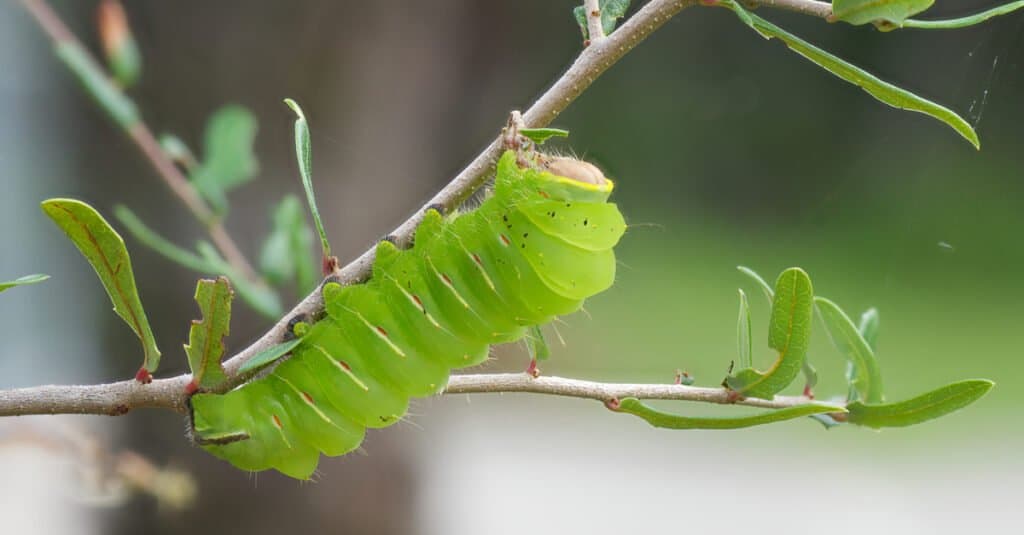
The Polyphemus moth caterpillar is one of the largest silk moths in North America.
©Chase D’animulls/Shutterstock.com
Growing up to 4 inches, Polyphemus caterpillars are common in Idaho and are renowned for their impressive size. They boast a striking green hue adorned with brown or black stripes, as well as eyespots on their back, which serve as a protective mechanism. These caterpillars consume a variety of plants including oak, apple, and willow trees. The Polyphemus moth, spanning up to 6 inches in wingspan, lives in forests, orchards, wetlands, and even urban areas. Male moths exhibit feathery antennae, while females showcase a vivid orange-red abdomen. These captivating moths are primarily active during nighttime hours and are drawn to artificial lighting sources.
4. The Hummingbird Clearwing Moth Caterpillar (Hemaris thysbe)
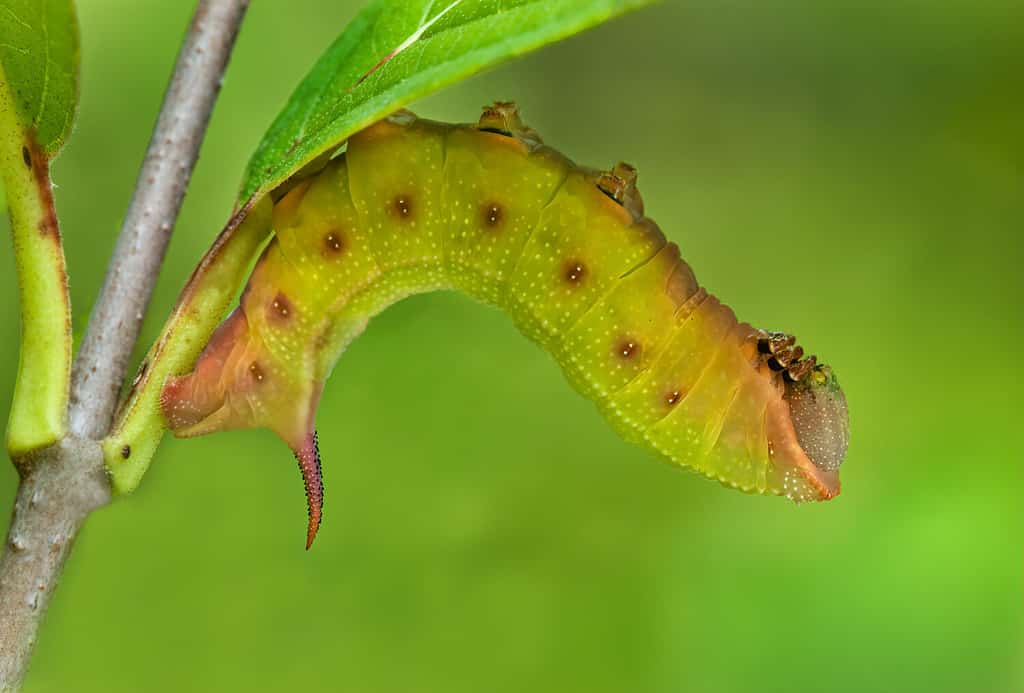
The caterpillars themselves are avid feeders, primarily consuming a diet of honeysuckle and snowberry.
©Gerry Bishop/Shutterstock.com
The caterpillars of the hummingbird hawk-moth present a fascinating study in ecology. Found in the rich, diverse habitats of Idaho, they display a unique and adapted life cycle. Their eggs, which are often nestled in the lush foliage, are hardy and designed to withstand the variable weather conditions of this region. The caterpillars themselves are avid feeders, primarily consuming a diet of honeysuckle and snowberry. As they grow, they contribute significantly to the local ecosystem, participating actively in plant pollination and serving as a vital food resource for birds and small mammals. Their role in the environment is indicative of the intricate web of life within Idaho’s varying landscapes.
5. Virginian Tiger Moth Caterpillar (Spilosoma virginica)
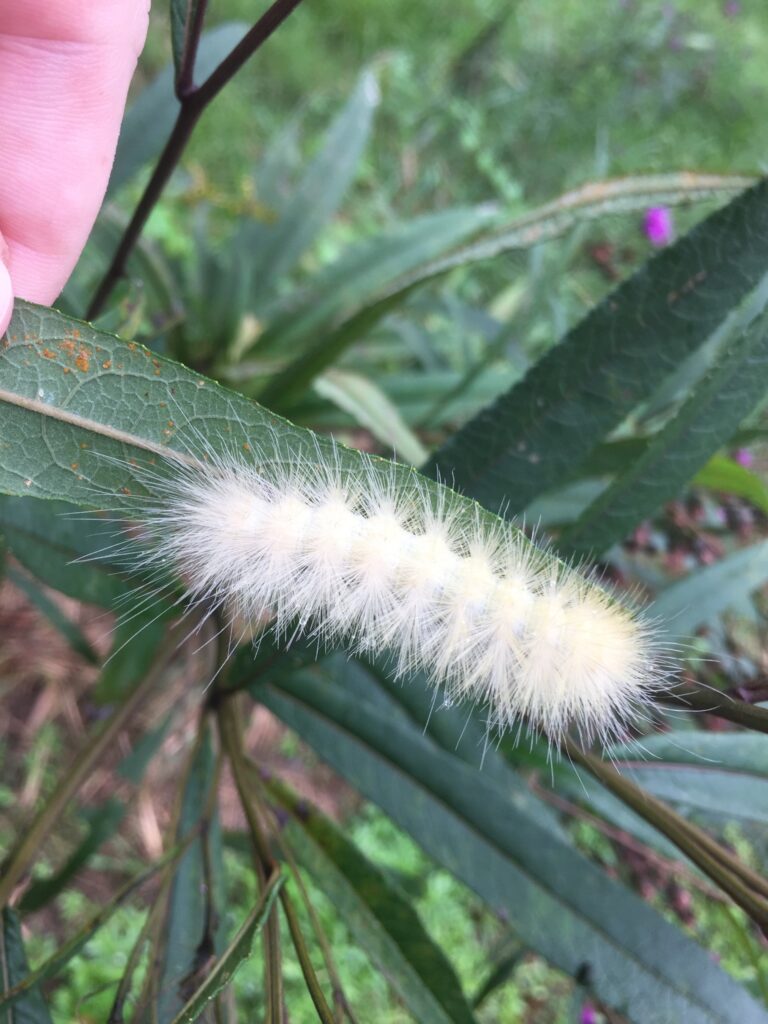
Caterpillars of the Virginian
tiger
moth are often called white-yellow woolly bears.
©35° 55′ 58.87″ N, 78° 56′ 37.5″ W Kartographer map based on OpenStreetMap. – License
The Virginian tiger moth caterpillar can be spotted during their caterpillar phase with their distinctive white, yellow, or orange woolly bear appearance. They thrive in a range of habitats, including woodlands, grasslands, and even wetlands. As they go through various stages of maturity and transitional periods, their physical appearance tends to change, impacting the coloration of their thick fur. This natural phenomenon adds an extra layer of intrigue to the already captivating world of these colorful caterpillars.
6. White-Lined Sphinx Moth Caterpillar (Hyles lineata)

White-lined sphinx moth caterpillars are not venomous.
©Wallenrock/Shutterstock.com
The habitat of the white-lined sphinx moth caterpillar is quite varied, helping its species to become widespread throughout North America. These larvae prefer open habitats, which can include everything from deserts to gardens and meadows. Unlike some of their colorful cousins, white-lined sphinx moth caterpillars pose no risk to humans. Their horn, despite its intimidating appearance, is not venomous and is primarily used to deter predators. This means these caterpillars can safely be observed and appreciated in their natural habitats.
7. Woolly-Bear Caterpillar (Pyrrharctia isabella)
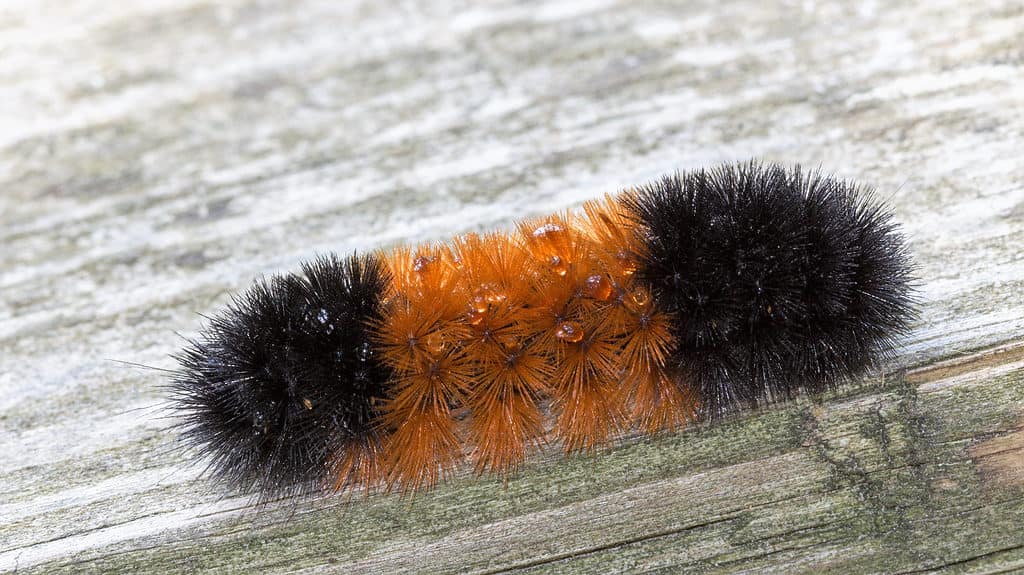
The wooly-bear caterpillar’s distinctive appearance features black bands adorning its ends, separated by a charming rusty brown band in the middle.
©Kimberly Boyles/Shutterstock.com
The woolly-bear caterpillar, a familiar sight in Idaho, is notable for its unique attributes. This larva has distinctive markings and is a prominent inhabitant of the state. Despite its somewhat daunting appearance, it is important to note that this species is not poisonous, posing no threat to humans. This member of the Promethea moth family lives in a variety of habitats, including rocky outcroppings, grassy areas, and meadows. However, they are most commonly spotted in open fields and gardens. Despite their wide range, they rarely stray far from human presence. During the summer months, these caterpillars can be seen migrating across the countryside in search of food and shelter.
8. The Spotted Tussock Moth Caterpillar (Lophocampa maculate)

Be cautious around spotted tussock moth caterpillars to avoid skin irritation.
©Amelia Martin/Shutterstock.com
The spotted tussock moth caterpillar resembles the white marked tussock moth caterpillar, but it stands out with a row of black spots on each segment. It can be found in various habitats including forests, meadows, and gardens. These caterpillars are stereotypically called “woolly-bear caterpillars” (not to be confused with the other woolly-bear caterpillars) because they are covered in dense hairs. Although its long, spiky hairs may irritate the skin, they are not harmful to humans. Unlike other tussock caterpillars, however, these guys don’t sting. They measure around 1 to 1.5 inches in length and feed on leaves of different trees like poplars, willows, birches, and oaks. During outbreaks, they can damage trees. In winter, they remain as caterpillars and transform into adult moths in spring. The adult moths have beautiful brown wings with yellow spots, measuring about 1 inch long.
9. The Milkweed Tussock Moth (Euchaetes egle)
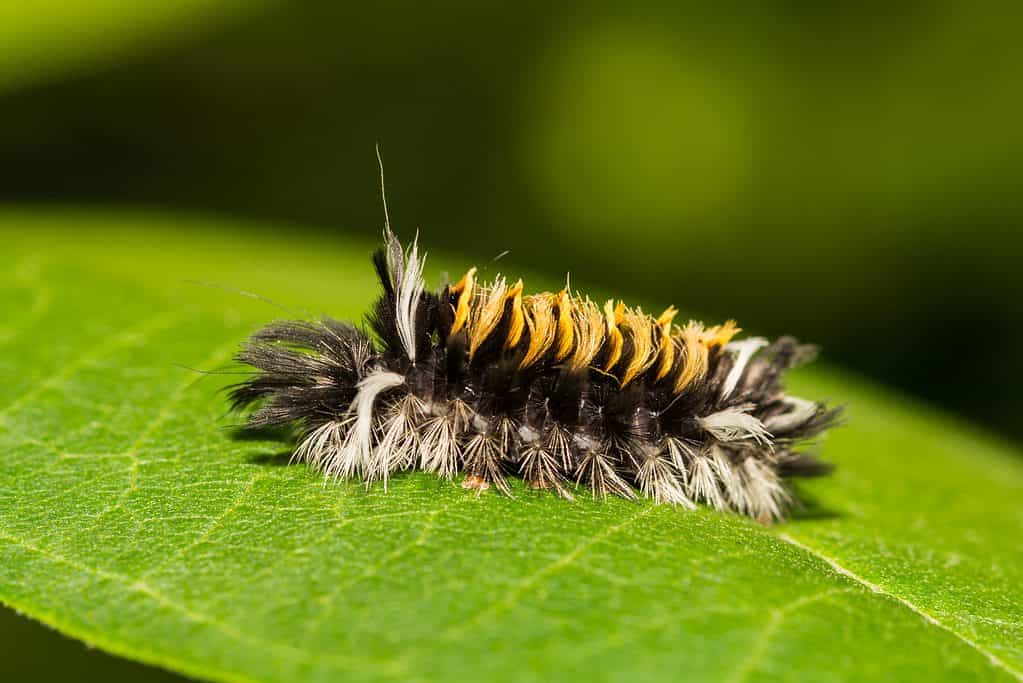
If you come across a milkweed tussock moth caterpillar in Idaho, observe it from a distance due to potential allergic reactions caused by its minute hairs.
©Jay Ondreicka/Shutterstock.com
Across North America, you can find the captivating milkweed tussock moth caterpillar, a member of the Erebidae family. It nourishes itself solely on milkweed plants, skillfully avoiding the toxic consequences. Its remarkable capacity to devour milkweed plants, unharmed by their toxins, remains a subject of great intrigue among researchers. Although not venomous, its delicate hairs may cause discomfort and irritation on the skin. During the winter, it stays in the larval stage, emerging as an adult moth in the spring. Despite its short lifespan, adult moths refrain from feeding.
10. Garden Tiger Moth Caterpillar (Arctia caja)
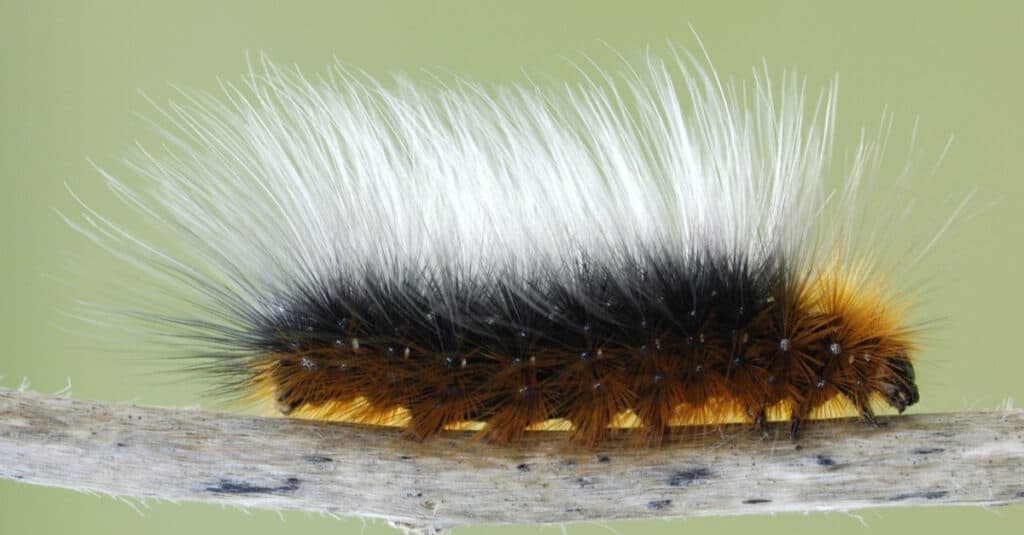
During the winter months, it remains in its caterpillar state and later undergoes pupation in spring.
©Hugh Lansdown/Shutterstock.com
The garden tiger moth caterpillar is native to regions such as Idaho, where it thrives in diverse environments ranging from coastal areas to woodlands. It is a versatile feeder, consuming a wide range of plants. Despite their striking appearance, these caterpillars have a rather humble diet, feeding mostly on common plants found in their habitat. During the winter months, they remain in their caterpillar state and later undergo pupation in spring. During their pupa stage, they metamorphose into the stunning garden tiger moth, exhibiting a vibrant transformation.
Butterfly Caterpillars in Idaho
11. Cabbage White Caterpillar (Pieris rapae)
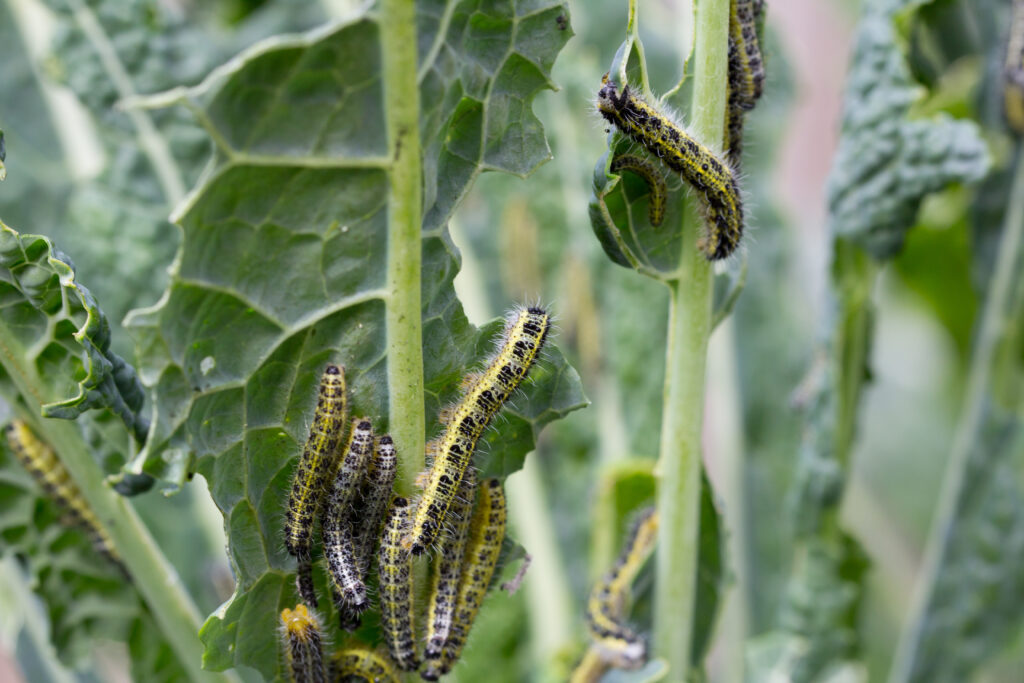
True to their name, cabbage white caterpillars eat cabbage plants.
©MagicBones/Shutterstock.com
The cabbage white caterpillar possesses a fascinating lifecycle closely intertwined with its habitat, which is predominantly cruciferous vegetable patches. The journey starts with eggs laid on the leaves of these particular vegetables, from which larvae, voracious leaf-eaters, emerge. It’s worth noting that despite their appetite for leafy greens, these caterpillars are not poisonous. As a larva grows, it experiences several molting cycles, shedding its skin to accommodate its increasing size. This rapid growth phase lasts about four weeks after which the caterpillar enters the pupal stage. In this protective casing, the larva transforms into a brown pupa measuring roughly 0.5 inches. After approximately two weeks, adult butterflies emerge, marking the completion of this remarkable life cycle.
12. Monarch Caterpillar (Danaus plexippus)

Monarch caterpillars exclusively rely on milkweed plants as their sole source of sustenance.
©Cathy Keifer/Shutterstock.com
The monarch butterfly caterpillar, a common spectacle in Idaho’s diverse ecosystems, is notable not just for its vivid and distinctive aesthetics. Another intriguing aspect of the monarch butterfly caterpillar is its toxic characteristics. The caterpillar feeds on milkweed plants, absorbing toxins which, although inoffensive to the caterpillar, are lethal to its predators. Despite its toxicity to predators, the monarch butterfly caterpillar is harmless to humans, thus its vibrant presence is a delightful sight in Idaho’s springtime scenery. Its life cycle, a natural wonder, is a transformative journey from a minuscule egg to a vividly patterned caterpillar, and finally into the renowned monarch butterfly. Originating from North America, monarch butterflies undertake an extraordinary migration, traveling south to Mexico for the winter.
13. Black Swallowtail Caterpillar (Papilio polyxenes asterius)
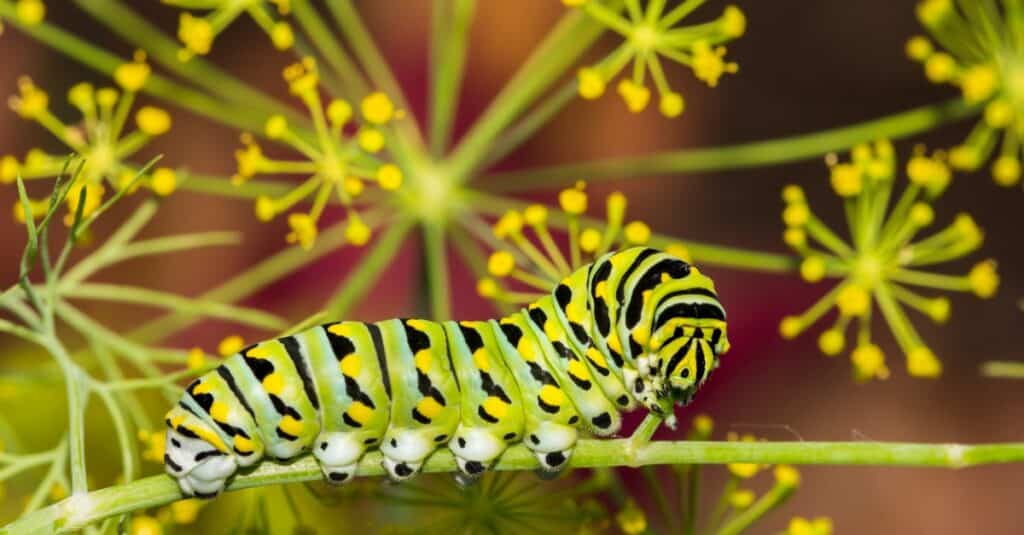
The black swallowtail caterpillar has a fascinating defensive organ called the osmeterium, which releases a repugnant odor when threatened.
©Jay Ondreicka/Shutterstock.com
The black swallowtail caterpillar emerges from late spring to early fall in Idaho. It has a vibrant green body with yellow and black stripes and a black horn at the tip of its tail. This caterpillar feeds on plants from the carrot family and goes through four instars or stages before transforming into a pupa. During the pupal stage, it undergoes a metamorphosis and becomes a butterfly with a wingspan of approximately 3 inches. From April to September, the butterfly feeds on nectar from various flowers. In winter, the black swallowtail butterfly seeks refuge in southern regions of the United States and Mexico and migrates northward in spring.
Poisonous Caterpillars of Idaho
Idaho is home to various caterpillar species with toxic properties. Should you happen to encounter a venomous caterpillar, it is vital to promptly cleanse the affected area with soap and water, and if needed, seek medical attention. Interestingly, caterpillars can be poisonous in a few different ways:
| Ways Of Being Poisonous or Venomous | Example / Description |
|---|---|
| Toxic body | Certain caterpillars consume poisonous plants and store the toxins within their bodies. If these caterpillars are ingested, their toxins have the potential to induce illness in their predators. |
| Venomous spines or hairs | These spines or hairs are frequently linked to glands containing venom. Upon contact, the spines or hairs detach and deliver the venom directly into the victim. |
| Poisonous liquid | Certain caterpillars have the remarkable ability to generate a toxic substance, which they release either from their mouths or their rear ends. This potent liquid is capable of causing skin irritation, intense burning sensations, and, in extreme cases, even blindness. |
It is worth noting that not all caterpillars with a poisonous appearance are toxic. If you are uncertain about a caterpillar’s toxicity, it is always prudent to err on the side of caution and refrain from touching it. Here are eight of the poisonous or venomous caterpillars that live in Idaho.
14. The White-Marked Tussock Moth Caterpillar (Orgyia leucostigma)
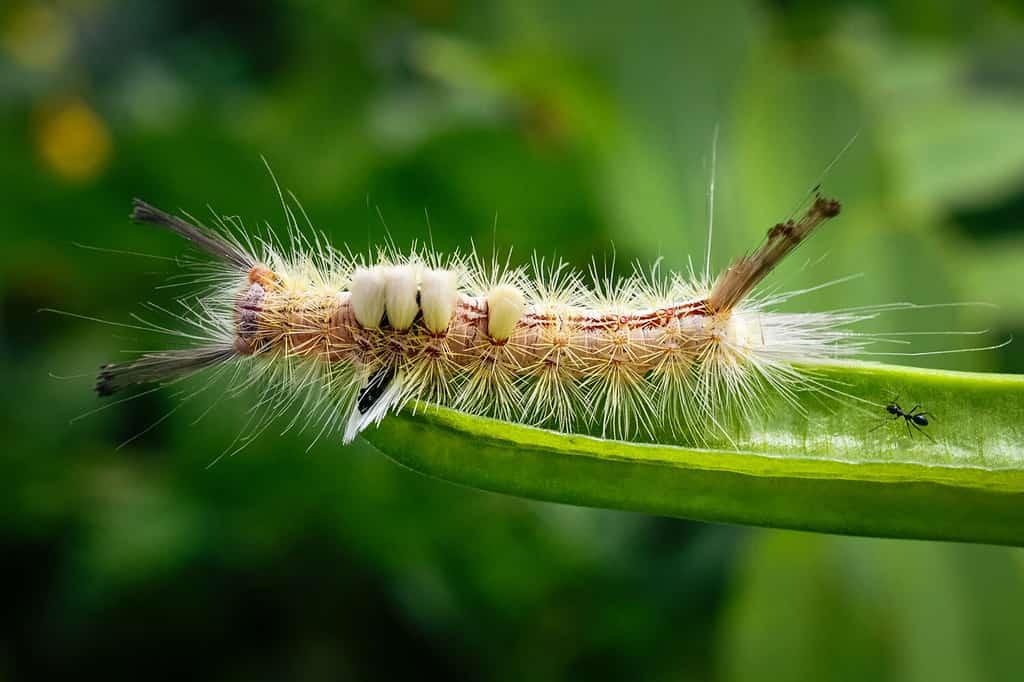
Although it may bear resemblance to other tussock moth caterpillars, outbreaks of these caterpillars tend to be short-lived.
©Satyashutter/Shutterstock.com
The white-marked tussock moth caterpillar is common in North America, including Idaho. This caterpillar typically measures around 1 to 1.5 inches in length with 13 distinct segments. Each segment has black hair and a row of yellow spots. It is worth noting that the caterpillar’s body is covered in urticating hairs, which have the potential to cause skin irritation and allergic reactions in susceptible individuals. The preferred foliage for the white-marked tussock moth caterpillar consists of willow, oak, maple, hackberry, and birch trees.
15. Douglas-Fir Tussock Moth Caterpillar (Orgyia pseudotsugata)
The Douglas-fir tussock moth caterpillar is a native insect found in forests across the western United States, including Idaho. These caterpillars can cause damage to Douglas fir, grand fir, and spruce trees by defoliating them. They have a distinct appearance with a brown body, white tufts of hair, and two large black eyespots on their head. Their life-cycle consists of four stages: egg, larva, pupa, and adult. Outbreaks of this periodic pest occur every eight to 12 years. If you come into contact with these caterpillars, be cautious as their hairs can cause skin irritation.
16. Western Tent Caterpillar (Malacosoma californicum)

These caterpillars build silken tents for protection.
©Wirestock Creators/Shutterstock.com
The western tent caterpillar is a moth in North America. It is common in mountains, forests, and gardens in western and southwestern Idaho. The caterpillar has a brown body with white hairs that contain toxins. Although they are not lethal to humans, touching a western tent caterpillar can cause itching, rash, swelling, tingling and burning, and other allergic reactions. Western tent caterpillars feed on trees and shrubs like willow, poplar, and aspen. These caterpillars can cause significant damage to trees by defoliating them. They have one generation per year, starting from eggs laid on tree bark. The adult moths are yellowish brown with black markings and have a wingspan of up to 2.5 inches wide.
17. Io Moth Caterpillar (Automeris io)
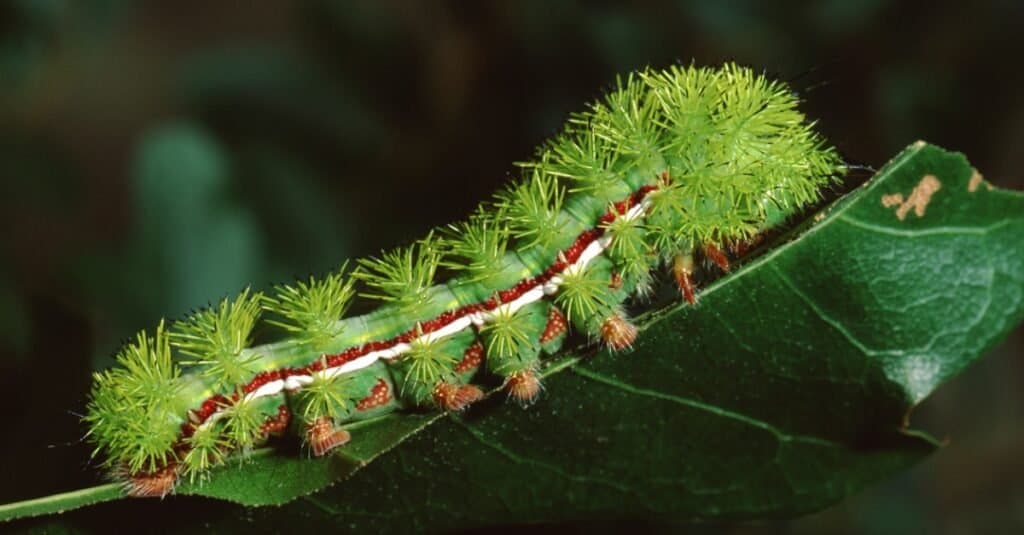
Io moth caterpillars have thick and bristly stinging spines that cause severe irritation in some people.
©iStock.com/Weber
Found in different habitats across Idaho such as forests, meadows, and woodlands, the Io moth caterpillar grows to an impressive length of 3 inches. Its body boasts vibrant shades of green with eye-catching yellow, orange, and black stripes. However, it is important to exercise caution in the presence of the Io moth caterpillar, for it possesses a venomous nature. The tiny hairs that cover its body have the potential to cause harm to humans. A mere touch of these hairs on human skin can lead to a range of discomforting symptoms, including rash, itching, burning, swelling, or blistering.
18. Banded Tussock Moth Caterpillar (Halysidota tessellaris)
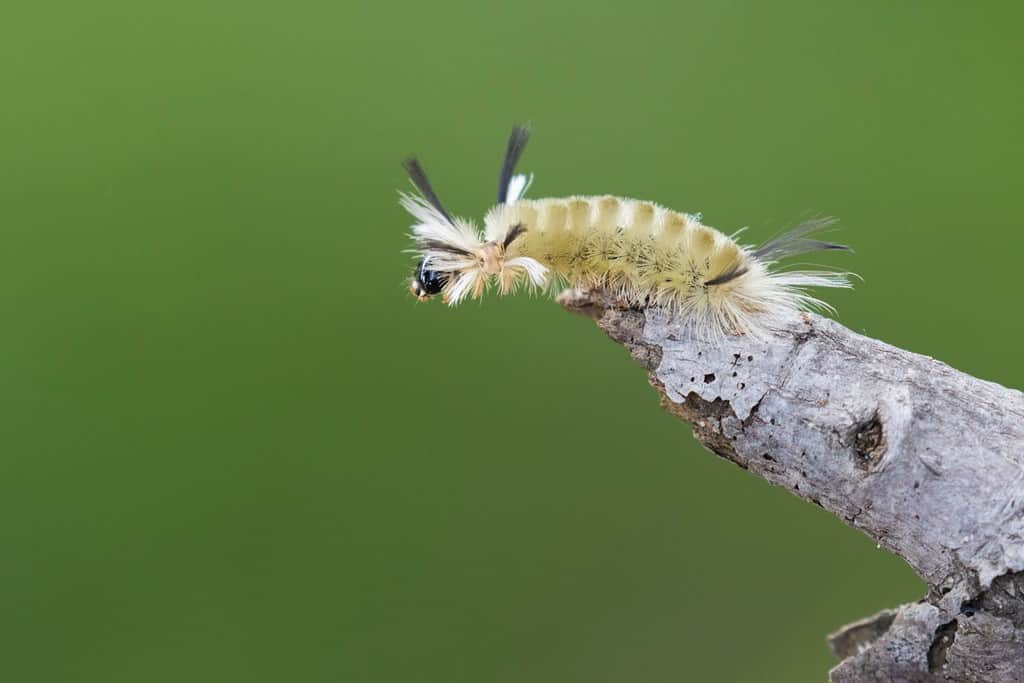
is also referred to as the pale tiger moth.
©Mircea Costina/Shutterstock.com
The banded tussock moth caterpillar is common in the beautiful forests of Idaho and across North America. This fascinating caterpillar, known for its distinct appearance, thrives on the leaves of various deciduous trees including oak, willow, tulip tree, and birch. It remains most active from mid-summer to autumn, munching on leaves to fuel its growth. As winter approaches, it retreats into a cozy, hairy cocoon where it awaits its transformation. If you happen upon a banded tussock moth caterpillar during your explorations in Idaho, it is best to simply appreciate its presence from a distance and let it go about its business. However, if curiosity gets the better of you and you feel the need to touch it, ensure your protection by wearing gloves and long sleeves, shielding yourself from its tiny hairs.
Summary of Caterpillars Found in Idaho
| Scientific Name | Common Name | Type |
|---|---|---|
| Callosamia promethea | Promethea moth caterpillar | Moth |
| Hyalophora cecropia | Cecropia moth caterpillar | Moth |
| Antheraea polyphemus | Polyphemus moth caterpillar | Moth |
| Hemaris thysbe | Hummingbird clearwing moth caterpillar | Moth |
| Spilosoma virginica | Virginian tiger moth caterpillar | Moth |
| Hyles lineata | White-lined sphinx moth caterpillar | Moth |
| Pyrrharctia isabella | Woolly-bear caterpillar | Moth |
| Lophocampa maculata | Spotted tussock moth caterpillar | Moth |
| Euchaetes egle | Milkweed tussock moth caterpillar | Moth |
| Arctia Caja | Garden tiger moth caterpillar | Moth |
| Pieris rapae | Cabbage white caterpillar | Butterfly |
| Danaus plexippus | Monarch caterpillar | Butterfly |
| Papilio polyxenes asterias | Black swallowtail caterpillar | Butterfly |
| Orgyia leucostigma | White-marked tussock moth caterpillar | Poisonous/Venomous |
| Orgyia pseudotsugata | Douglas-fir tussock moth caterpillar | Poisonous/Venomous |
| Malacosoma californicum | Western tent caterpillar | Poisonous/Venomous |
| Automeris io | Io moth caterpillar | Poisonous/Venomous |
| Halysidota tessellaris | Banded tussock moth caterpillar | Poisonous/Venomous |
The photo featured at the top of this post is © Kimberly Boyles/Shutterstock.com
Thank you for reading! Have some feedback for us? Contact the AZ Animals editorial team.







